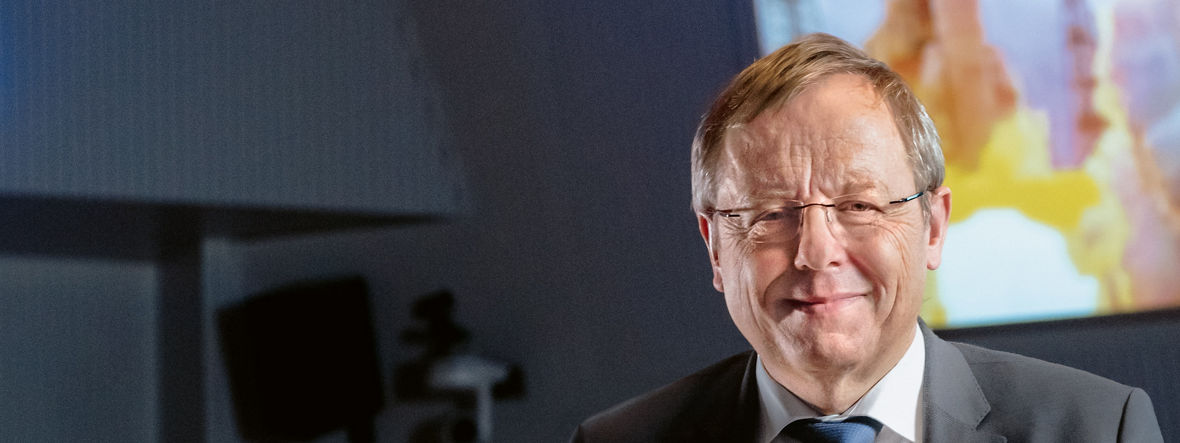Millions of people are familiar with the main control room of the European Space Operations Center in Darmstadt because they’ve seen it on television. This is where technicians of the European Space Agency ESA monitor the trajectories and systems of rockets and modules during missions such as the launch of the Mercury probe BepiColombo last October. On this winter day, the control room is reserved for the Elements interview with the Director General of the ESA, Johann-Dietrich “Jan” Wörner. Wörner strides into the room briskly and throws his blue service parka across a table. Its right sleeve bears the logo of the Horizons mission, which ended last December when the German astronaut Alexander Gerst returned to Earth from the ISS. “I have to do a little PR work here,” he says with a laugh. Then he sits down in one of the chairs that are usually occupied by his technicians.
Professor Wörner, the Chinese have just successfully sent a probe to the moon, and the Americans are also preparing for a new moon mission. How come the moon is celebrating a comeback these days, almost 50 years after the Apollo 11 landing?bant fast 50 Jahre nach der Landung von Apollo 11 ein Comeback?
JAN WÖRNER The trend is actually not “Back to the moon”—it’s “Forward to the moon.” This time it’s not a competition between two superpowers. Instead, all of us will be working together. The landing on the far side of the moon is a huge success for Chinese space technology. I would be delighted if the international cooperation in space becomes even closer in the future. For this reason, I believe that the moon has great geopolitical value.
You yourself have proposed the establishment of a “Moon Village.” What’s behind this idyllic space scenario?
The concept didn’t come from me, but I’ve adopted it because I like the analogy. If you set up a village here on earth, it’s not because of a government decree but because lots of people with very different interests have come together. In the same way, the Moon Village is aimed at bringing together various interests, such as robotics or astronautical projects, on a shared platform. The stakeholders are national aerospace agencies, research institutes, and industrial companies.
Why is there currently so much interest in the moon?
For rational reasons. If someone believes that astronauts can fly to Mars in just a few years, I can explain to that person very quickly why this wouldn’t work. Mars has an atmosphere and a gravitational force that is about 40 percent as strong as the Earth’s. A spacecraft that is landing on Mars and being launched from it must overcome factors that don’t exist on the moon. In other words, it needs a rocket and propellant. In addition, if human beings are traveling such a long distance in space, you have to do something to maintain their health. I can’t imagine people traveling for two years without having any access to medical care. And there’s the constant high level of radiation.

What insights do you hope to gain from a new mission to the moon?
We have relatively little knowledge about the moon. All of the moon landings in the 1960s and 1970s took place near the moon’s equator, where the surface is dry and dusty. But if you go to the poles, you’ll find water. We could build observatories on the far side of the moon and look out at space from there.
Do you expect deposits of raw materials to be discovered on the moon?
There are companies that hope to transport raw materials from the moon to the earth. I’m skeptical in this regard, because I think our rockets are simply too expensive for that. But I can imagine companies transporting tourists to the moon. Fortunately, human beings have an inborn desire to travel to places they haven’t been to yet. Incidentally, that’s also a reason why I’m placing my bets on space travel by astronauts. People obviously believe that personal experience is very important.
A cooperative enterprise on the moon—that sounds intriguing. But shouldn’t we be worried that other participants could siphon off the knowledge that Europeans have gained?
Imagine that you’re an alien and that you’re able to see, hear, and understand everything that happens on Earth. Would you be confident that you could immediately tell the good people from the bad ones? I doubt that. Besides, in our global system isolation has never worked, and it’s never helped anyone. Openness is the only thing that has gotten anything done. The ESA cooperates with many countries all over the world—but of course we’re being cautious.
In the USA, more and more private companies offering space travel, such as Blue Origin, SpaceX, and Virgin Galactic, are entering the market. Is Europe missing out on this trend?
It’s simply not the case that we’re lagging far behind. Just look at OHB, the developer of the Galileo satellites. It used to be a very small company: Otto Hydraulik Bremen. At some point it got involved in space travel—and now it’s even planning to develop its own small rocket. Arianespace, which launches our booster rockets into space, is also a private company.
»It’s good to know that our system gives us the opportunity to put ideas into practice«
And it’s now under tremendous pressure from its new competitors in the USA.
I won’t deny that it’s under pressure. So far, Ariane 5 has operated very successfully—not because it was especially inexpensive but because of its reliability and because we’ve got a favorably situated takeoff site in French Guiana. Ariane 6, which will be launched for the first time in July 2020, will cost only half of what we spent on Ariane 5. Elon Musk obviously has a good business model at SpaceX. But he’s operating with special boundary conditions regarding the salaries and social insurance of his employees, as well as the contracts with NASA and other partners. We can’t keep pace in this competition as things stand…
…and one of the main reasons for that is the structure of the ESA, with its 22 members. How do you plan to convince them that they should invest more money in space travel?
A comprehensive assessment of our activities has shown that every euro that is invested in space travel results in six euros’ worth of benefits. But there’s another effect that I think is at least equally important: We’re suffering from the “European sickness”—pessimism about the future. It’s not good for a continent’s outlook to constantly be telling the next generation that problems are all we have.
That’s why we’re asking about the opportunities.
Outer space is fascinating. If we land on a comet, people say, “Wow!” And when Alexander Gerst spends half a year on the International Space Station, they’re thrilled too. This is an important positive brain process. Some people note how others are transforming a dream into reality. And a few of them say, “I can do that too.” It’s good to recognize that our system gives us the opportunity to put ideas into practice. I hope to convey this message to society through the medium of space travel.

Most taxpayers probably pay rather more attention to concrete results. What would you say to them?
Space travel is infrastructure. The precise measurement of time is done via satellites. Modern weather forecasts, navigation, telecommunication—all of these things would be unthinkable without space travel. All of our energy networks are coordinated from space. In addition, through space travel we can develop new materials such as titanium aluminide, an alloy that can be used for turbine blades. In alloying processes you have to check the materials’ viscosity. On earth, if you keep the materials at the same temperature for a while, the alloy either falls apart or it solidifies. We’re even thinking about producing pharmaceuticals under zero gravity conditions in space.
»Fortunately, human beings have an inborn desire to travel to places they haven’t been to yet«
In the past, industrial companies have not been very interested in space-based research. The only experiment on the ISS that was completely financed by an industrial company was the testing of a cream from Evonik. How do you explain that?
Well, it needs some time to develop. After Michael Faraday discovered electromagnetic induction in 1831,
it still took many decades for industry to transform this discovery into products. We have to have patience. We’ve recently started offering companies an inexpensive opportunity to conduct tests on the International Space Station—our “Ice Cubes.” You simply have to send us a device measuring 10 by 10 by 10 centimeters or a multiple of that. We’ll shoot it up into the ISS, where the experiments are conducted. It costs €50,000.
In 2018, 111 rockets were launched worldwide—more than ever before. Don’t you have to give more thought to the environmental aspect of space travel?
The ESA accounted for only a small number of this total, but environmentally friendly fuels are an important topic for us. In our boosters we use solid-fuel rockets, which are actually not very environmentally friendly. That also goes for kerosene and hydrazine, which is used as a propellant in rockets, satellites, and space probes. By contrast, oxygen and hydrogen, the propellants for the central stage of the Ariane, are very clean, just like electric drive systems.
Recently you’ve even been using atmospheric air. How does that work?
The “air breathing” process uses molecules of atmospheric air. As a result, we need a significantly smaller oxygen tank on board. Methane could also be used as a fuel in the future. Hydrogen has to be cooled to -250°C to make it liquid so that it can be pumped into the thrusters. For methane we need only -170°C. Besides, methane is denser and thus can be managed more easily inside the tank. We’re also considering electric drive systems that accelerate ionized molecules in electric fields.

For months, people breathlessly listened to Alexander Gerst’s reports from the ISS about his experiments and his impressions of the Earth. Are you sad because your most important ambassador in space has now come back to Earth?
On the contrary, now he’s available all the time. Thomas Reiter returned from space for the last time in 2006, but today he’s still traveling on our behalf every other day. Even astronauts such as Ernst Messerschmid, Reinhold Ewald, and Ulf Merbold—when they make a public appearance we’re guaranteed to have standing room only. And Matthias Maurer, who hasn’t made his first space flight yet, is surrounded by crowds at events. I think that’s fantastic.
Professor Wörner, you’re 64 years old. What other milestones would you like space travel to reach during your lifetime?
(considers the question) I’d rather not say. The ESA is based on four pillars. If I were to single out just one project, I’d have a problem with the representatives of the other three pillars. All I can tell you is that for me, the progress of the Moon Village project is very dear to my heart.
The European Space Agency ESA
From its headquarters in Paris, it coordinates the space-related activities of its 22 member states. The agency, which was founded in 1975, has an annual budget of about €5.6 billion. Its most important functions include the ongoing development of satellite-supported navigation and telecommunication, conducting observations of the Earth, and researching the solar system. The ESA is a project partner of the International Space Station ISS.



